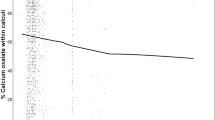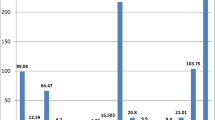Summary
In a previous study we showed that the magnesium-calcium ratio of tap water is negatively correlated with the incidence of calcium-containing urinary stones. In this study we examined the relationship between the incidence of struvite stones, water hardness and the regional geological features on the basis of our previous study and an epidemiological study of urolithiasis performed in Japan. The magnesium-calcium ratio of tap water was found to correlate positively with the incidence of struvite stones. The tap water magnesium-calcium ratio was high in regions of basalt and sedimentary rock and was low in granite and limestone areas. The incidence of struvite stones in the regions of basalt and sedimentary rock was higher than that in the granite and limestone areas. Thus, this study suggested that the incidence of struvite stones is related to the magnesium-calcium ratio of tap water and to the regional geology, as is the case for calcium-containing stones.
Similar content being viewed by others
References
Churchill D, Bryant D, Fodor G, Gault MH (1978) Drinking water hardness and urolithiasis. Ann Intern Med 88:513
Donaldson D, Pryce JD, Rose GA, Tovey JE (1979) Tap water calcium and its relationship to renal calculi and 24 h urinary calcium output in Great Britain. Urol Res 7:273
Gleeson MJ, Griffith DP (1990) Infection stones. In: Resnick MI, Pak CYC (eds) Urolithiasis: a medical and surgical reference. Saunders, Philadelphia, p 113
Iguchi M, Kataoka K, Kohri K, Yachiku S, Kurita T (1984) Nutritional risk factors in calcium stone disease in Japan. In: Ryall R, Brockies JG, Marshall (ed) Urinary stone. Churchill-Livingstone, Melbourne, p 34
Kohri K, Kodama M, Ishikawa Y, Katayama Y, Takada M, Katoh Y, Kataoka K, Iguchi M, Kurita T (1989) Magnesium-to-calcium ratio in tap water, and its relationship to geological features and the incidence of calcium-containing urinary stones, J Urol 142:1272
Mandel N, Mandel G (1990) Epitaxis in renal stones. In: Wickham JEA, Buck AC (eds) Renal tract stone: metabolic basis and clinical practice. Churchill-Livingstone, Edinburgh, p 87
Shuster J, Finlayson B, Scheaffer R, Sierakowski R, Zoltek J, Dzegede S (1982) Water hardness and urinary stone disease. J Urol 128:422
Sierakowski R, Finlayson B, Hemp G (1976) Water hardness and the incidence of urinary calculi. In: Finlayson B, Gainesville WCT (eds) Colloquium of renal lithiasis. University Presses of Florida, chapter 22
Takasaki E (1972) The magnesium: calcium ratio in the concentrated urines of patients with calcium oxalate calculi. Invest Urol 10:147
Yoshida O (1979) Epidemiology of urolithiasis in Japan. Jpn J Urol 70:975
Yoshida O, Okada Y (1990) Epidemiology of Urolithiasis in Japan: a chronological and geographical study. Urol Int 45:104
Author information
Authors and Affiliations
Rights and permissions
About this article
Cite this article
Kohri, K., Ishikawa, Y., Iguchi, M. et al. Relationship between the incidence infection stones and the magnesium-calcium ratio of tap water. Urol. Res. 21, 269–272 (1993). https://doi.org/10.1007/BF00307709
Received:
Accepted:
Issue Date:
DOI: https://doi.org/10.1007/BF00307709




